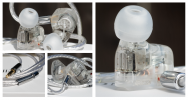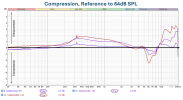Hello, this is a review of the TANCHJIM KARA IEM. This is my personal pair and costs US $179, but it is on sale on Amazon now for $143.

This review will cover acoustic measurements of the TANCHJIM Kara IEM.
Product Info, Physical Appearance and Size
Kara is a hybrid IEM with 1 dynamic driver and 4 balanced amateur drivers in a 3-way design. It features a fully transparent 3D printed resin housing and a transparent face plate. Here is some more info about the product on the box:

The transparent design allows you to see each and every one of the drivers and the crossover circuitry from the outside. I really like the wire that came with KARA. It's soft and thin with very little memory, fitted with a very simple plug.

The shape of the Kara is very similar to the Truthear Zero, but smaller in width and length, making it easy to wear even for people with small ears. The only thing to note is that it's quite thick, so it hangs out of my ear more than other IEMs, especially the front (near nozzle) portion. Overall, I find it easy to wear and comfortable enough, but not outstanding. Nozzle diameter is 6mm.

Here is a demonstration with both IEMs fitting into a KEMAR pinna. The fit in the image is close to how they fit in my ears. If you have smaller ears, however, this could be the one for you.

The Kara comes with a carrying case that is quite large. It can fit at least two to three pairs of IEMs in there. Although it's a nice gesture, I think it's not the most practical and I recommend TANCHJIM to choose something different going forward.
 Acoustic Measurements
Acoustic Measurements
Acoustic measurements are made with IEC 60318-4(711) compliant ear coupler and the stock medium sized tips (smaller front opening, as the images above showed).

Measured the same as the plot included on the back of the box. Overall compliance with target is good but has too much upper bass, and the bass shelf drops in amplitude in the sub bass region.

The normalized response shows the deviations from target more clearly. Kara has a 3dB mid bass boost and some big boosts past 15kHz.

distortion performance is okay until about 104dB, beyond that you get higher distortion across the board. This is not the best distortion performance in IEMs but it's quite common among balanced amateur IEMs. It's not reasonable to expect the same level of distortion performance as dynamic drivers.

Distortion level shows similar story. Distortion is dominated by third order harmonics.

group delay is very clean.

Frequency response compression measurements show that there could be noticeable compression at and beyond 104dB SPL. It looks like the boost beyond 15kHz gets more extreme at higher volumes.
I’m glad to see dynamic compression measurement results on a few ASR speaker reviews recently. Simultaneously, I was measuring dynamic compression on IEMs and I want to share some results here.
I measured dynamic compression using a continuous sine sweep that is 2 seconds in length. I measured the frequency response at 84dB SPL, and then increase my signal generator level in 10dBV increments into my headphone amp to measure the frequency response at 94, 104, and 114dB SPL in consecutive orders without removing or adjusting the headphone in the ear coupler between measurements. After, I normalize the results at 94, 104, and 114dB SPL to the measurement at 84dB SPL, and then add appropriate offsets to the normalized curves so they would all line up at 0 if there is no compression. I hope this measurement can better explain distortion from headphones and the perceptual effects compression can cause at transients.
Besides measuring compression on KARA, I also measured dynamic compression on three other IEM’s, so we can have a starting point to compare between products. I chose three IEM’s that have different driver configurations, them being:
Moondrop CHU: $19, Single dynamic driver IEM

AKG N5005: $1000, discounted to $160, Hybrid IEM with 1 dynamic driver and 4 balanced armature drivers

Softears RSV: $730, 5 balanced armature driver IEM

Sorry for going off topic for a bit. Last but not least, headphone impedance

Conclusion
Kara has good compliance with target at the pinna gain region and slightly elevated mid bass. In listening, I noticed the elevated mid bass to be quite obvious at louder listening levels, but actually quite engaging and punchy at lower listening levels. Combined with the treble boost above 10k, I think it sounds better than the target-perfect IEMs at lower volumes, maybe due to the equal loudness contours of the human ear. I would look into this IEM if you 1. Have smaller ears and need smaller IEMs for fit, 2. Listen to music at lower levels often. And, of course, if you are into the transparent, minimalistic design. The IEM market is so completive now and it's easy to find $50 products that follows the target perfectly. I think Kara distinguishes itself from the competition enough through tuning and design to find a target audience.
This review will cover acoustic measurements of the TANCHJIM Kara IEM.
Product Info, Physical Appearance and Size
Kara is a hybrid IEM with 1 dynamic driver and 4 balanced amateur drivers in a 3-way design. It features a fully transparent 3D printed resin housing and a transparent face plate. Here is some more info about the product on the box:
The transparent design allows you to see each and every one of the drivers and the crossover circuitry from the outside. I really like the wire that came with KARA. It's soft and thin with very little memory, fitted with a very simple plug.
The shape of the Kara is very similar to the Truthear Zero, but smaller in width and length, making it easy to wear even for people with small ears. The only thing to note is that it's quite thick, so it hangs out of my ear more than other IEMs, especially the front (near nozzle) portion. Overall, I find it easy to wear and comfortable enough, but not outstanding. Nozzle diameter is 6mm.
Here is a demonstration with both IEMs fitting into a KEMAR pinna. The fit in the image is close to how they fit in my ears. If you have smaller ears, however, this could be the one for you.
The Kara comes with a carrying case that is quite large. It can fit at least two to three pairs of IEMs in there. Although it's a nice gesture, I think it's not the most practical and I recommend TANCHJIM to choose something different going forward.
Acoustic measurements are made with IEC 60318-4(711) compliant ear coupler and the stock medium sized tips (smaller front opening, as the images above showed).
Measured the same as the plot included on the back of the box. Overall compliance with target is good but has too much upper bass, and the bass shelf drops in amplitude in the sub bass region.
The normalized response shows the deviations from target more clearly. Kara has a 3dB mid bass boost and some big boosts past 15kHz.
distortion performance is okay until about 104dB, beyond that you get higher distortion across the board. This is not the best distortion performance in IEMs but it's quite common among balanced amateur IEMs. It's not reasonable to expect the same level of distortion performance as dynamic drivers.
Distortion level shows similar story. Distortion is dominated by third order harmonics.
group delay is very clean.
Frequency response compression measurements show that there could be noticeable compression at and beyond 104dB SPL. It looks like the boost beyond 15kHz gets more extreme at higher volumes.
I’m glad to see dynamic compression measurement results on a few ASR speaker reviews recently. Simultaneously, I was measuring dynamic compression on IEMs and I want to share some results here.
I measured dynamic compression using a continuous sine sweep that is 2 seconds in length. I measured the frequency response at 84dB SPL, and then increase my signal generator level in 10dBV increments into my headphone amp to measure the frequency response at 94, 104, and 114dB SPL in consecutive orders without removing or adjusting the headphone in the ear coupler between measurements. After, I normalize the results at 94, 104, and 114dB SPL to the measurement at 84dB SPL, and then add appropriate offsets to the normalized curves so they would all line up at 0 if there is no compression. I hope this measurement can better explain distortion from headphones and the perceptual effects compression can cause at transients.
Besides measuring compression on KARA, I also measured dynamic compression on three other IEM’s, so we can have a starting point to compare between products. I chose three IEM’s that have different driver configurations, them being:
Moondrop CHU: $19, Single dynamic driver IEM
AKG N5005:
Softears RSV: $730, 5 balanced armature driver IEM
Sorry for going off topic for a bit. Last but not least, headphone impedance
Conclusion
Kara has good compliance with target at the pinna gain region and slightly elevated mid bass. In listening, I noticed the elevated mid bass to be quite obvious at louder listening levels, but actually quite engaging and punchy at lower listening levels. Combined with the treble boost above 10k, I think it sounds better than the target-perfect IEMs at lower volumes, maybe due to the equal loudness contours of the human ear. I would look into this IEM if you 1. Have smaller ears and need smaller IEMs for fit, 2. Listen to music at lower levels often. And, of course, if you are into the transparent, minimalistic design. The IEM market is so completive now and it's easy to find $50 products that follows the target perfectly. I think Kara distinguishes itself from the competition enough through tuning and design to find a target audience.
Attachments
Last edited:



